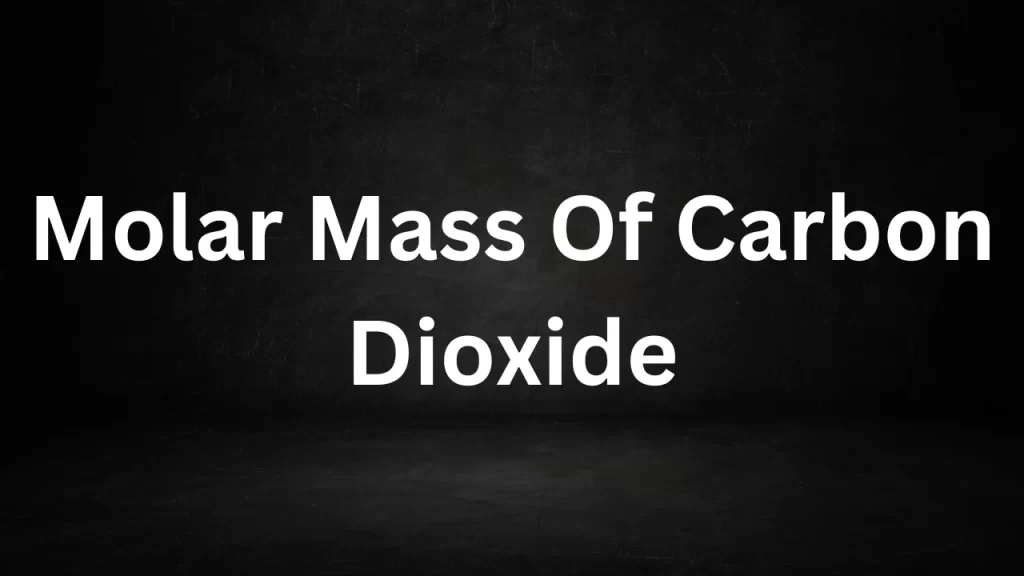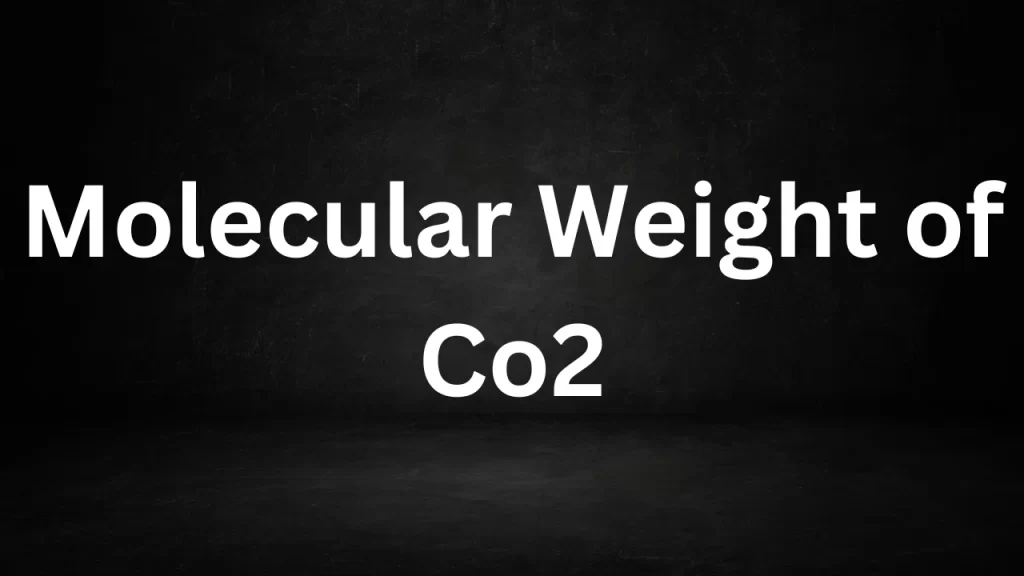Tag: molar mass of co2
Molar Mass Of Carbon Dioxide
Molar Mass Of Carbon Dioxide: The molar mass of carbon dioxide (CO2) is a fundamental concept in chemistry that plays a pivotal role in understanding chemical reactions, stoichiometry, and the behavior of gases.
This value is not only essential for academic purposes but also finds practical applications in various fields, including chemistry, environmental science, and industry. In this article, we will delve into the molar mass of carbon dioxide, its calculation, significance, and practical applications.

Molar Mass Of Carbon Dioxide
Defining Molar Mass
Molar mass denotes the weight of one mole of a specific substance, usually expressed in grams per mole (g/mol). In the case of carbon dioxide (CO2), the mol mass represents the combined mass of one mole of carbon (C) atoms and two moles of oxygen (O) atoms.
The Calculation
To determine the mol mass of carbon dioxide, we need to sum the atomic masses of its constituent elements, carbon (C) and oxygen (O), using their respective atomic masses found on the periodic table. The molar mass of carbon is approximately 12.01 g/mol, while the molar mass of oxygen is approximately 16.00 g/mol.
Using these values, we can calculate the molar mass of CO2 as follows:
Molar Mass of CO2 = (Molar Mass of C) + 2 × (Molar Mass of O) Molar Mass of CO2 = (12.01 g/mol) + 2 × (16.00 g/mol) Molar Mass of CO2 ≈ 44.01 g/mol
So, the mol mass of carbon dioxide (CO2) is approximately 44.01 grams per mole.
Significance in Chemistry
- Stoichiometry: The mol mass of carbon dioxide is crucial in stoichiometry, which involves calculating the quantities of reactants and products in chemical reactions. It helps chemists determine the amount of CO2 produced or consumed in a reaction.
- Gas Laws: In the study of gases, the molar mass of CO2 is used in various gas laws, such as the Ideal Gas Law, to relate the mass, volume, pressure, and temperature of gases.
- Combustion Reactions: Understanding the mol mass of CO2 is essential in combustion reactions, as it helps in calculating the amount of carbon dioxide produced when a substance burns.
Real-World Applications
- Environmental Science: Knowledge of the mol mass of CO2 is vital for measuring and monitoring greenhouse gas emissions, particularly in the context of climate change research.
- Industrial Processes: Industries utilize the molar mass of CO2 in processes such as carbon capture and storage (CCS), where CO2 is captured to reduce emissions.
- Food and Beverage Industry: The mol mass of CO2 is relevant in carbonation processes, as it helps in determining the amount of carbon dioxide needed to create carbonated beverages.
Conclusion
The mol mass of carbon dioxide (CO2), approximately 44.01 g/mol, s a fundamental concept in chemistry with wide-ranging implications. It serves as a key component in stoichiometry, gas laws, and combustion reactions, contributing to our understanding of chemical processes. Furthermore, its significance extends to real-world applications in environmental science, industry, and even everyday consumables. Understanding the molar mass of CO2 is not only a core concept in chemistry but also a crucial aspect of addressing contemporary environmental challenges.
Read More
- Difference Between Force And Momentum
- Law Of Conservation Of Linear Momentum
- Molecular Weight Of MgSO4
- Molecular Weight Of H3PO4
- Molecular Mass Of CaCl2
Frequently Asked Questions (FAQs) On Molar Mass Of Carbon Dioxide
1. What is the molar mass of carbon dioxide (CO2)?
The mol mass of carbon dioxide (CO2) is approximately 44.01 grams per mole (g/mol).
2. How is the molar mass of carbon dioxide calculated?
The molar mass of CO2 is determined by summing the molar masses of carbon (C) and two oxygen (O) atoms due to the molecule’s composition. The molar mass of C is approximately 12.01 g/mol, and the mol mass of O is approximately 16.00 g/mol.
3. Why is knowing the molar mass of carbon dioxide important?
Understanding the mol mass of CO2 is essential in chemistry for stoichiometry, gas laws, and combustion reactions. It also has real-world applications in environmental science, industry, and food and beverage production.
4. What is stoichiometry, and how is the molar mass of carbon dioxide used in it?
Stoichiometry is the study of the quantitative relationships between reactants and products in chemical reactions. In stoichiometry, the molar mass of CO2 calculates the CO2 amount in chemical reactions.
5. How is the molar mass of carbon dioxide relevant to the study of gases?
CO2’s molar mass is vital in gas laws, linking mass, volume, pressure, and temperature.
Molecular Weight of Co2
Molecular Weight of Co2: Carbon dioxide (CO2) is a chemical compound that plays a significant role in various natural processes, climate change, and industrial applications.
Understanding its molecular weight is crucial in chemistry, environmental science, and engineering. In this article, we will explore the molecular weight of CO2, its composition, and its relevance in different fields.

mol Weight of Co2
mol Composition of CO2
Carbon dioxide (CO2) is composed of one carbon atom (C) and two oxygen atoms (O), bonded together through covalent bonds. Its chemical formula, CO2, reflects this composition, indicating one carbon atom and two oxygen atoms in a single molecule.
mol Weight of CO2
The mol weight of a substance is calculated by adding the atomic weights of all the atoms in its chemical formula. To determine the mol weight of CO2, we consider the atomic weights of carbon (C) and oxygen (O):
- The atomic weight of carbon (C) is approximately 12 atomic mass units (amu).
- The atomic weight of oxygen (O) is approximately 16 amu.
Now, let’s calculate the mol weight of CO2:
mol Weight of CO2 = (Atomic Weight of C) + 2 × (Atomic Weight of O) mol Weight of CO2 = 12 amu + 2 × 16 amu Molecular Weight of CO2 = 12 amu + 32 amu Molecular Weight of CO2 = 44 amu
Therefore, the mol weight of carbon dioxide (CO2) is 44 atomic mass units (amu).
Significance of the mol Weight of CO2
The mol weight of CO2 holds significant importance across various scientific disciplines:
1. Chemistry:
In chemistry, the mol weight of CO2 is essential for stoichiometry, which involves the calculation of reactant and product quantities in chemical reactions. It helps determine the balanced chemical equations and the molar relationships between substances in a reaction.
2. Environmental Science:
Understanding the mol weight of CO2 is vital in environmental science and climate change research. CO2 is a greenhouse gas, and its molecular weight influences its behavior in the atmosphere, including its role in trapping heat and contributing to global warming.
3. Industry and Engineering:
In industrial processes, the molecular weight of CO2 is relevant for designing equipment, such as compressors and separators, used in the extraction, storage, and transport of carbon dioxide. It is also crucial in carbon capture and storage (CCS) technologies.
4. Health and Safety:
In safety assessments and industrial hygiene, the molecular weight of CO2 is considered when evaluating its effects on human health. High concentrations of CO2 can be hazardous, affecting respiration and leading to asphyxiation.
5. Education and Research:
The mol weight of CO2 is a fundamental concept taught in chemistry and science education. It forms the basis for understanding chemical reactions, gas properties, and environmental issues.
Conclusion
The mol weight of carbon dioxide (CO2), calculated as 44 atomic mass units (amu), is a critical parameter with broad implications in chemistry, environmental science, industry, and safety. It governs the behavior of CO2 in various contexts, from chemical reactions to its role as a greenhouse gas. As we continue to grapple with climate change and environmental challenges, a deep understanding of CO2’s molecular weight remains indispensable in addressing these global issues.
Read More
- Molecular Mass of Water
- Difference Between Cyclone And Hurricane
- Molecular Weight Of Na
- Molecular Mass Of O2
- Molecular Mass of H2
Frequently Asked Questions (FAQs) Molecular Weight of Co2
Q1: What is the mol weight of CO2 (carbon dioxide)?
A1: The mol weight of carbon dioxide (CO2) is 44 atomic mass units (amu). This value is calculated by adding the atomic weights of one carbon atom (approximately 12 amu) and two oxygen atoms (approximately 16 amu each) in a CO2 molecule.
Q2: Why is knowing the mol weight of CO2 important?
A2: Understanding the mol weight of CO2 is important in various fields. In chemistry, it’s essential for stoichiometry and reaction calculations. In environmental science, it’s crucial for studying climate change and greenhouse gas emissions. It also has significance in industrial processes, safety assessments, and education.
Q3: How is the molecular weight of CO2 used in stoichiometry?
A3: In stoichiometry, the molecular weight of CO2 is used to calculate the molar relationships between substances in a chemical reaction. It helps determine the balanced chemical equations and allows for the calculation of reactant and product quantities.
Q4: What is the role of CO2’s mol weight in climate change research?
A4: CO2’s mol weight plays a role in climate change research because it influences how CO2 behaves in the atmosphere. CO2 is a greenhouse gas, and its molecular weight affects its ability to trap heat, contributing to global warming and climate change.
Q5: How is the mol weight of CO2 relevant in industry and engineering?
A5: In industry and engineering, the mol weight of CO2 is relevant for designing equipment used in processes involving CO2, such as compressors and separators. It’s also crucial in carbon capture and storage (CCS) technologies, which aim to mitigate CO2 emissions from industrial sources.
Molecular Mass of Water
Difference Between Cyclone And Hurricane
The Molecular Weight Of Na
Molecular Mass Of O2
Molecular Mass of H2